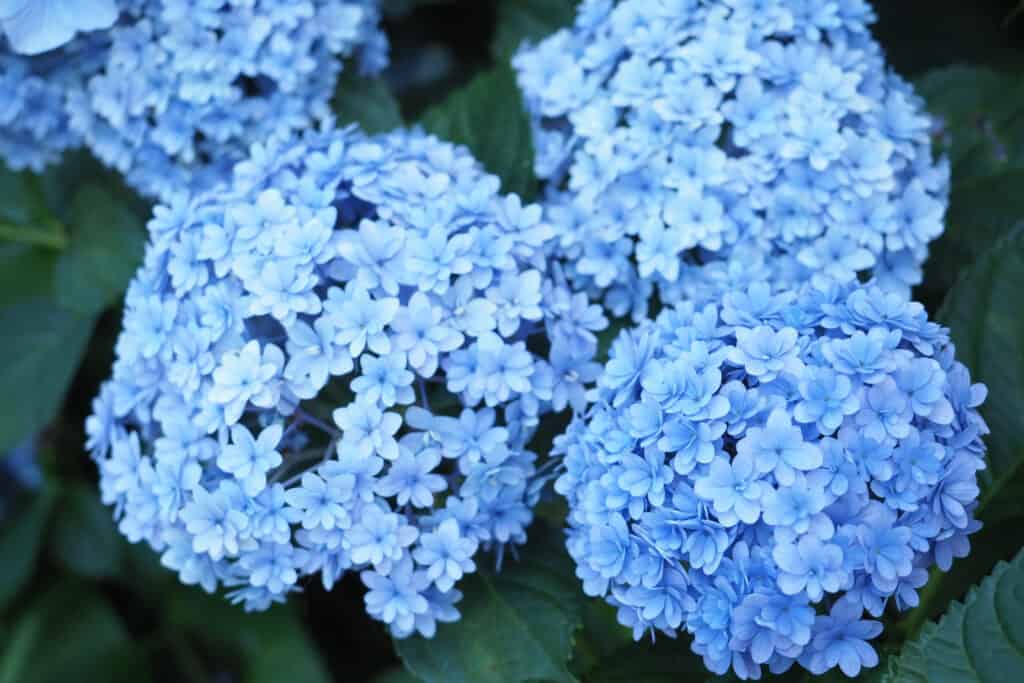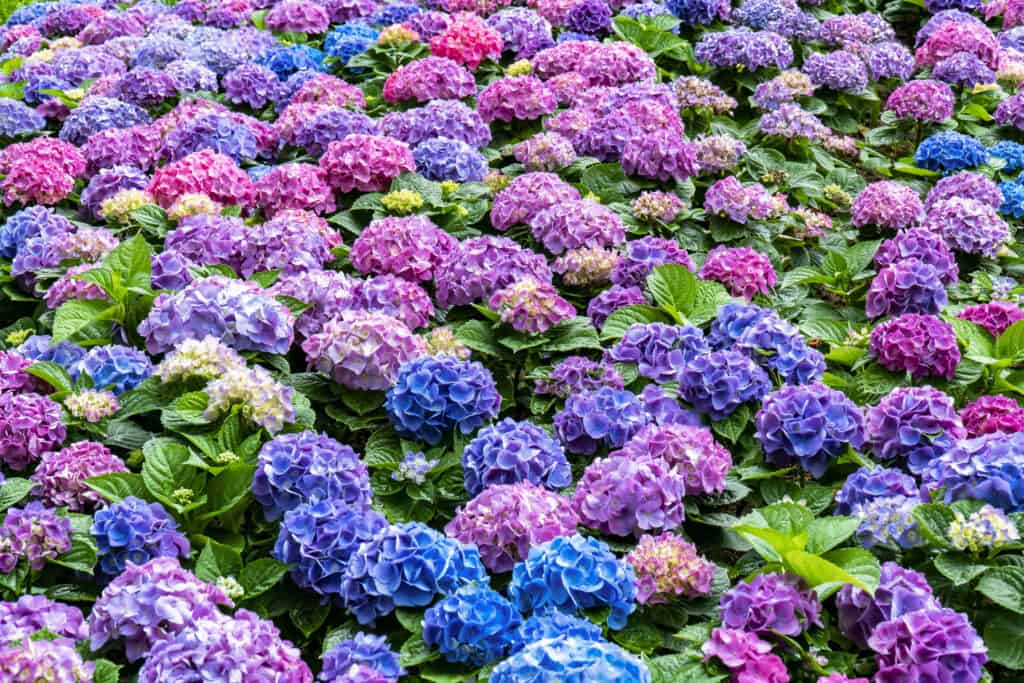If you looked at a viburnum plant and a hydrangea plant side by side, you might not even know the difference between the two, depending on the species planted near. But they are, in fact, quite different plants with different properties, uses, and qualities that you’ll want to investigate before adding them to your garden space.
Let’s take a look at these two similar-looking plants and see which one might be your best bet for home.
| Viburnum | Hydrangea | |
|---|---|---|
| Classification | Virburnum opulus; 150 species, multiple cultivars | Hydrangea; up to 80 species of hydrangea plants, with 7 commonly grown in North America |
| Description | Viburnum come in many flowering types, primarily with white to pink flowers. They have colorful berries in a range of colors and typically have 3-lobed dark green leaves and grow anywhere from 2 to 30 feet in height. | Hydrangea bushes and trees come in a wide range of floral colors from white, blue, red, pink, purple, lavender, green, and shades between. |
| Uses | These plants are used for borders and margins, specimen pieces, and foundations, as well as privacy and hedge rows. Viburnum have been used in many home remedies, primarily associated with muscle relaxation for conditions like asthma, muscle cramping, and hypertension. | Hydrangeas are used for primarily aesthetic purposes such as border plants and hedge rows, though they have also been used in medicinal treatments primarily for infections of the digestive system. |
| Origins and growing preferences | Viburnum are native to subtropical Eurasia and North America, grow well in Zones 2 to 9 and need nutrient-rich, well-draining soil with full sun. | Hydrangeas have an excessively long history, dating way back in the fossil records presumed to be at the 23 million mark, in North America. They also have been growing in Asia for millennia. They do well in Zones 2 to 7 and require plenty of light and water. |
| Special features and fun facts | Viburnums were thought to be part of the honeysuckle family originally, but more recent research has shown them to belong to a very different family. Some of their berries are edible, while others are toxic – so beware! | Hydrangea plants are largely favored for their beautiful flowers – which you can change the colors of, based on the supplements you add to the soil in which they are planted. |

Viburnums and hydrangeas can be heard to tell apart on first glance.
©PAUL ATKINSON/Shutterstock.com
Key Differences Between Viburnum and Hydrangea
The two flowering plants look very similar, but there are some key differences between them, including flower shapes, leaf shapes, fruit, and more. Be sure to know the differences between not just viburnum vs. hydrangea, but the varieties you’re growing. Some of the varieties have different needs, while others have different uses.
Viburnum vs. Hydrangea: Classification
Viburnums, or viburnum wrightii, are among 150 species of flowering, fruiting shrubs. The plant is deciduous and evergreen. The plant is also known as the European cranberry bush, due to its red berries that pop out each year. The plant has flowers and is in the moschatel family in the Adoxaceae family.
Hydrangea, also commonly known as hortensia,are a popular flowering plant that looks similar to viburnums. Each species of hydrangea has its own designation, such as Mountain Hydrangea the common name for hydrangea macrophylla Seratta or Lacecap Hydrangea the common name for hydrangea macropylla normalis. There are dozens of types of hydrangeas and up to 80 species of the flowering plant. The types most commonly grown in North America include Mountain, Bigleaf, Lacecap, Smooth, Panicle, Oakleaf, and Climbing.

Hydrangeas come in a wide variety of colors and shapes.
©qiufan bu/Shutterstock.com
Viburnum vs. Hydrangea: Description
Viburnum bushes, much like hydrangea, come in a range of plant types, with different floral aspects. The plant has lacecap varieties, which are often confused with lacecap hydrangeas, for example, but the big difference in looks that makes them easy to tell apart is that viburnum have berries. The fruit looks like cranberries (thus the nickname “cranberry bush”). The plant has florets that form into flowers, the cranberry-esque fruit pops out, and the leaves are dark green with three lobes. The leaves could be confused with certain types of maple leaves out of context of the shrub.
Viburnum plants may be anywhere between 2 and 30 feet in height, meaning they have a huge range of sizes. This means it’s important to find the varieties/species you need for your space or you could well wind up with something far too large or too small for your needs. The flowers may be fragrant and sweet to rather unpleasant smelling, depending on variety. Another difference between the two is that viburnum flowers are typically white and cream shades to pink, but not the other more vivid blues and purples of hydrangeas. The fruits, however, may be yellow, orange, pink, blue, red, or black.
Hydrangeas, on the other hand, come in a wide range of colors, including white, blue, red, pink, purple, light purple, green, and shades between. The colors of the flowers change by the soil textures as well, depending on the pH of the soil or the presence of aluminum ions. Hydrangeas are typically somewhere between 2 and 15 feet, with leaves that come in a range of shades of green and sizes and shapes.

Viburnum are also commonly called Chinese snowballs, depending on the type.
©luckakcul/Shutterstock.com
Viburnum vs. Hydrangea: Uses
Typically, viburnums are used as shrub borders or garden foundations to create a unique and lovely “framework” for a garden space. They’re often used as hedges, privacy rows, woodland margins, and specimen plants as well. The key on these uses will be the height of the given variety you have chosen to grow. The dried bark of the plant has been known to be used in some remedies including for nervous system relaxant, anti-asthmatic uses, to help with hypertension, as a muscle relaxant, as a sedative, or as a diuretic. Some folks have used this bark has also been used to treat menstrual cramping, uterine pain, and arthritis pain.
Hydrangeas are used from some of the same aesthetic purposes, including hedge rows, border plants, hedges for homes, specimens, and other foundational pieces for creating borders and garden spaces. The variety you choose will help you determine their use. The root and rhizome of hydrangeas have been used to create medicinal treatments. Most commonly, these treatments have been for urinary tract infections, bladder infections, kidney stones, and similar conditions, as well as hay fever. There is no specific scientific information that supports this plant for use in these medical conditions, however.
Before using any plants in your home remedies or as supplements purchased from retailers, be sure to check with your medical care professionals.

If you mix up the pH in your soil, you can grow a range of hydrangea colors all in the same area.
©iStock.com/phanasitti
Viburnum vs. Hydrangea: Origins and Growing Preferences
The approximate 175 of the types of viburnums may be found natively grown in subtropical Eurasia or North America, with some species native to Malaysia as well. The North American varieties may be known as the wayfaring tree or hobblebush, and they’re native to the eastern side of North America.
The plant does best in Zones 2 to 9 in the United States, planted in either spring or fall. The best way to grow them, however, is from established plants that are at least two or three years old. Find them at nurseries, home and garden centers, and similar locales for best results. They don’t require specific soil types, though they want well-drained, nutrient-rich soils. If the soil you have isn’t the best, add some compost to boost it for their growth. Most varieties need full sun planting, but some varieties handle a little bit of shade. Protect them from the wind and be sure to plant several together for cross-pollination, as they are not self-pollinators.

Hydrangeas come in a huge range of colors, including pale yellow greens.
©Bonnie Taylor Barry/Shutterstock.com
Hydrangeas date as far back as we can find records, with fossil records believed to come in at 23 million years old. The fossils from this era were found in Jaw Mountain in Alaska, for the Hydrangea alaskana in a rock dating back to the aleogene period. Other forms of this plant date back thousands of years when known cultivation began in areas of Asia and all throughout Europe and North America. The Asian varieties made their way to Europe in the 1770s, with an explosion in popularity around that time.
You may grow hydrangeas from seeds or plants, depending on your own skill level and preferences. The plants need to be planted in areas with plenty of light, near a water source (i.e., with plenty of watering), with plenty of sun. They do well in Zones 3 to 7, with different needs depending on the locale. In northern regions, plant hydrangeas where they will get all day sun. In southern regions, plant them where they’ll receive morning sun and afternoon shade to avoid burning them out. Make sure they have well-draining soil – and plant them in either early spring or early autumn.
Viburnum vs. Hydrangea: Special Features and Fun Facts
Viburnums are actually evergreen shrubs that flower. They were originally thought to be a part of the honeysuckle family, but over the years as deeper research as done, the plant was switch into the family of moschatels, or Adoxaceae instead. Some of the flower species in the Viburnums family are made into jams, but some are toxic, so it’s important to know which species you’ve got on hand! The long stems of the plant are pretty solid, too, and in past were used as shafts for arrows – and many archers still prefer arrows made from these plant shafts.

Viburnum berries look tempting to eat but they could be toxic, so check the variety first!
©photowind/Shutterstock.com
One of the most unique and distinctive things about hydrangea plants is that you can change the color of the flowers based on how you treat the soil in which they are planted. The pH levels determine the colors: 5.5 and lower produces blue flowers; 5.5 to 6.5 produces purple; 6 to 6.2 produces white; anything over 7 will produce pink. Hydrangeas also technically don’t have petals, but rather sepals, which are leaves that protect the flower bud. These sepals are how to consume water, too, meaning they do best with water directly applied to their flowers. Hydrangeas are also technically toxic, as they contain lower levels of cyanide. And finally, Hydrangea Day is January 5, in case you need an excuse to celebrate these gorgeous flowers!
Next Up:
- Are Hydrangeas Poisonous to Cats or Dogs?
- Hydrangea vs. Rhododendron
- Plants that Like Coffee Grounds
- Plants that Repel Spiders
The photo featured at the top of this post is © Edita Medeina/Shutterstock.com
Sources
- Missouri Botanical Garden, Available here: https://www.missouribotanicalgarden.org/PlantFinder/PlantFinderDetails.aspx?taxonid=278939
- The Naturalpathic Herbalist, Available here: https://thenaturopathicherbalist.com/herbs/v-z/viburnum-opulusprunifolium/
- Britannica, Available here: https://www.britannica.com/plant/viburnum
- HGTV, Available here: https://www.hgtv.com/outdoors/flowers-and-plants/trees-and-shrubs/how-to-grow-viburnums
- Proven Winners, Available here: https://www.provenwinners.com/learn/landscaping/hydrangea-glossary
- Wikipedia, Available here: https://en.wikipedia.org/wiki/Hydrangea
- https://www.rxlist.com/hydrangea/supplements.htm (1970) RX List
- WebMD, Available here: https://www.webmd.com/vitamins/ai/ingredientmono-663/hydrangea
- Mr. Plant Geek, Available here: https://mrplantgeek.com/2020/07/01/history-of-hydrangeas/
- Miracle Gro, Available here: https://www.miraclegro.com/en-us/library/trees-shrubs-landscaping/how-grow-hydrangeas
Thank you for reading! Have some feedback for us? Contact the AZ Animals editorial team.






